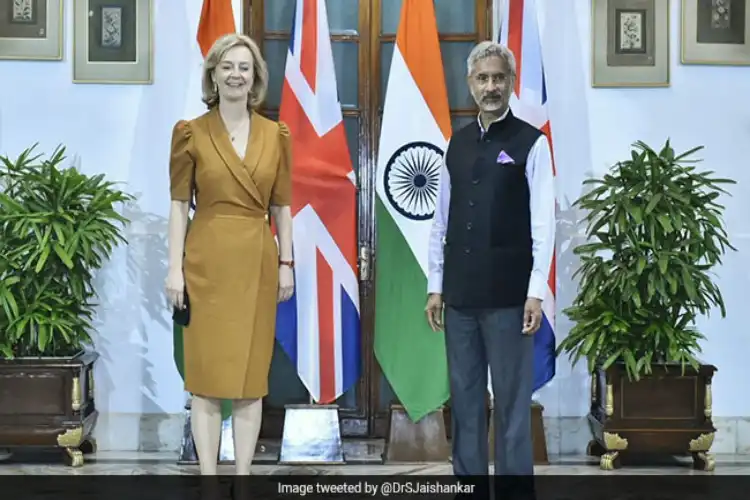
 Sushma Ramachandran
Sushma Ramachandran
Much has been talked about recently regarding the colonial legacy, the symbols of the Empire, and the need to do away with them. The discussion began with the renovation of the Central Vista in the capital and the unveiling of the Netaji statue on the India Gate lawns. The renaming of Rajpath as Kartavya Path to remove colonial overtones also had its share of controversy just before the longest reigning British monarch, Elizabeth II passed away. Yet despite the drive towards decolonisation, India decided to declare a day of mourning for the head of state of a country that ruled over it for 200 years.
This pragmatic decision reflects the policies of an independent sovereign nation that is seeking to have greater economic linkages and a vastly different relationship with a country that was formerly its colonial master. Times have changed and both countries have their self-interest while seeking closer ties. India and the UK are keen to promote a more vigorous economic engagement than ever before with the highlight being the conclusion of a bilateral free trade agreement. The new British Prime Minister Liz Truss has already made it clear that she seeks to deepen existing Indo-UK ties in the post-Brexit era which has increasingly alienated that country from its neighbours.
India’s rise in the economic comity of nations and its alluringly large market are also key reasons for this growing interest. While its per capita income remains far below that of the UK, it has pepped that country recently to become the world’s fifth largest economy. It is also the fastest growing economy right now with an expectation of 7.5 percent growth in the current fiscal. Its inflation management is probably the envy of more developed countries which are facing 40 year highs like the U.S at 8.1 percent.
The UK too is grappling both with inflationary pressures, high fuel prices, and pressure on its currency. Having moved out of the European Union, it will lose many of its trading benefits on that continent. It is thus looking to expand its trade partnerships and India is high on the priority for concluding an FTA.
The U.K. has already been disappointed that there is little prospect of a free trade deal with its close ally, the U.S. which has made its position clear on this issue. It had been anticipated that after Brexit, the country would be able to enter into several meaningful bilateral trade pacts without having to go through the bureaucracy of the EU. These are not coming as easily as had been expected by Brexiteers. Truss has therefore decided to focus on membership in the Trans-Pacific Partnership (TPP) along with trade deals with the Gulf Cooperation Council and, more importantly, India.
This country is equally keen to push for an early conclusion to the proposed Indo-UK FTA. The target for finalising an early harvest agreement has been set for Diwali or the end of October this year. India is similarly anxious to enter into a bilateral trade agreement with one of the world’s biggest economies.
The U.S. has already indicated its disinterest in any trade pact for the time being. And the proposed free trade agreement (FTA) with the European Union has been languishing for nearly a decade. The reasons are partly India’s rigidity on tariffs on key products and partly the EU’s reluctance to delink the FTA with an investment pact.
The U.K.’s interest at this stage thus aligns with this country’s needs as it is in a hurry to conclude more bilateral trade pacts. One of the key issues for the Indian side is the easing of visa curbs to allow skilled professionals from here to live and work in that country. In addition, it is looking forward to lower tariffs on exports of labour-intensive products. The British side, on its part, is keen to have market access for legal services and reduced tariffs on imports of Scotch and automobiles. Other areas being explored are the production of British defense equipment in this country and cooperation in areas like artificial intelligence and data exchange.
The Indo-British deal also needs to be viewed in the context of this country’s reluctance to become part of any multilateral trade agreements in the region. It declined to join the Regional Comprehensive Economic Cooperation (RECP) owing to fears of Chinese goods being dumped here via third countries. It stayed away despite the RECP being an overarching trading bloc that includes the ten ASEAN countries along with Australia, China, Japan, New Zealand, and South Korea. It has also kept aloof from the trade pillar of the recently concluded Indo-Pacific Economic Framework (IPEF). This is not a free trade agreement but is viewed as a precursor to one and consists of four pillars – fair and resilient trade, supply chain resilience, clean energy and tax, and anti-corruption. Currently, the IPEF comprises 14 Indo-Pacific countries including Australia, New Zealand, Indonesia, and the U.S.
According to Commerce Minister Piyush Goyal, for the time being, it is staying out of the trade pillar owing to possible binding commitments on labour, environment, and digital trade.
ALSO READ: India needs to be atmanirbhar in oil seeds, pulses
In sharp contrast to its reluctance to enter into multilateral agreements, India is keen to enter into bilateral trade pacts, especially with longstanding partners like the U.K. The demise of Queen Elizabeth II is an apt occasion to reflect on the fact that ties between the two countries are shifting to a different kind of relationship.
The trade pact is significant not just because it will increase trade flows but it also highlights the increased bilateral investment between the two countries. The proposed deal with the European Union will not be as pathbreaking as this one, given the enormous amount of financial and corporate ties between India and the UK. The colonial legacy has been left far behind. This is now a relationship between two countries that are among the largest economies in the world and seek to collaborate for their mutual benefit.
